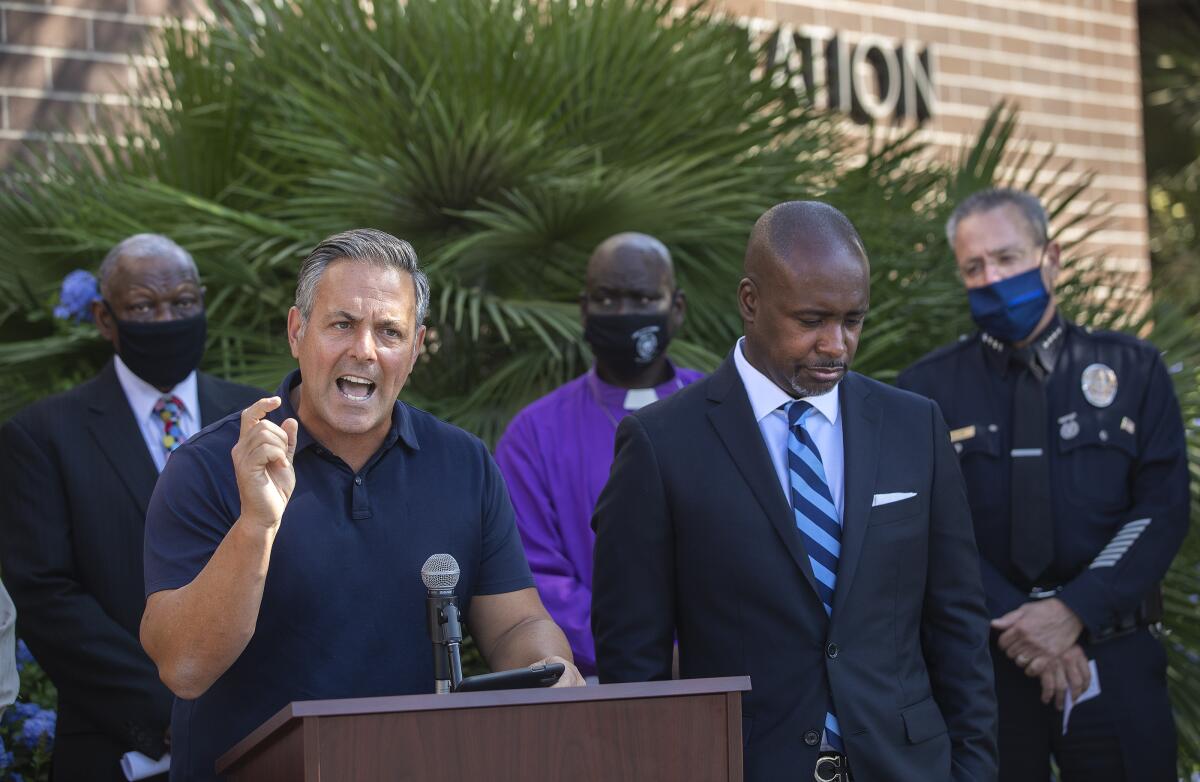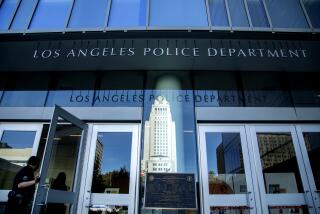Editorial: In Los Angeles, murder is back. Now what?

Crime in Los Angeles has been on the decline for so long that it’s easy to forget the years, in the fairly recent past, when parts of the city felt like they were under continuous, violent siege and L.A. was the murder capital of the United States.
Homicide took more than 1,000 lives a year in this city during stretches of the 1980s, 1990s and early 2000s.
And then the number dropped below 500, and then 400, and then lower still. 2019 marked the lowest crime rate since statewide numbers were first tabulated, and the 10th straight year in which homicides in Los Angeles fell short of 300. That’s still far too many killings for a city that wants to see itself as healthy and just, and whose leaders brazenly called it the first or second “safest big city in America.” But in comparison with the years that came before, it felt like a reprieve.
Now, murder is back.
Although early months of the pandemic kept people inside and drove down most crime even further, homicide in Los Angeles crept upward. And then, beginning in June, it exploded. Killings are up nearly 15% over last year. Shooting victims include 40 children, nine of them younger than age 10. That’s just within Los Angeles city limits, and does not include the violence that damages neighborhoods across the region.
Oddly, overall crime continues to fall throughout L.A. Even violent crime is down — except for the shootings and killings.
Other big cities across the nation are dealing with the same phenomenon, swept by a spate of violence over the summer and into October. Detroit, for example, and Memphis, Birmingham, Baltimore and St. Louis. And Stockton. And San Bernardino.
These were not the physical altercations and vandalism that marred political protests against police brutality and systemic racism. These were wanton shootings of children, the elderly, strangers, neighbors.
Some blame the panic caused by the virus and the economic shutdown, and indeed, we are beset by anxiety and a sense that the rules and the order of civil society no longer apply. Some people respond by virtually embracing family and friends. Some respond by buying guns.
Some blame the lack of summertime youth programs, closed down by the pandemic at a time when teenagers were nevertheless out of school with few constructive things to do.
Some blame the “Minneapolis effect” — an extension of the supposed Ferguson effect, which is the theory that police respond to criticism of their heavy-handed tactics by pulling back and watching the mayhem that ensues. In Los Angeles, at least, police insist they are not shrinking back despite public anger over what has often appeared to be needless force in the handling of protests, which in turn were responses to police killings in other cities — George Floyd, Breonna Taylor, Rayshard Brooks — and here in Southern California — Andres Guardado and Dijon Kizzee, among others. The violence, whether coming from criminals or from cops, is disproportionately borne by Black people and, in Los Angeles, also by Latinos.
Whatever the cause, LAPD Chief Michel Moore and other city officials are again using an expression that was refreshingly candid a decade ago, when city leaders acknowledged that reducing crime required more than just adding police officers: We’re not going to arrest our way out of this.
But there’s a corollary principle, one that may be uncomfortable to remember during a year in which politicians struggle to follow the shifts in political winds: We’re not going to defund our way out of this either.
In the 1990s and the first decades of the new century, the pattern in Los Angeles was unmistakable: Add cops, and violent crime drops. Remove cops, and violent crime jumps. It’s the same in most cities. It will most likely continue to be.
The lesson of this summer — one of them, anyway — is that the formula was always incomplete. Add cops who act like an occupying army, who disrespect the dignity of people they are meant to protect, who stop people with insufficient reason, who shoot when they don’t have to, and all the violence that is suppressed for a year or five years or a decade will righteously burst forth in anger against those who are supposedly there to keep the peace. It should be no surprise that people want and need — and deserve and demand — to be protected from violence whether it comes from their neighbors or their police.
The LAPD drove down previous spikes in murder, especially in South L.A., by deploying what is routinely referred to as the “elite” Metropolitan Division. But Los Angeles needs a different kind of elite cop — officers who do more than search cars and bash heads.
Some say it’s too late, that the LAPD has lost all credibility in Black and Latino neighborhoods, that the only way forward is to drastically reduce and eventually eliminate contacts between residents and police. It is certainly true that there are jobs police should never do, that they fell into only through inattention, expediency and the most bizarre historical circumstances. For example, armed, uniformed cops take the temperatures of Angelenos entering the City Council chambers to testify. Really?
And it is true as well that when Los Angeles invested in its police force during the 1980s and 1990s, it failed to invest in the health, safety, education, housing, economic development and well-being of the neighborhoods that deserved those investments, leaving police as the only response to crisis and social breakdown.
But whatever magic formula is concocted to end the killing and make wounded communities whole will not consist of simply moving money out of one pot and into another. It’s nowhere near that easy, and yet it’s not complicated: Los Angeles’ most injured neighborhoods — Black communities in South L.A. and Pacoima, Latino communities entwined with them and on the Eastside and in the Valley — need exactly what they needed 30 years ago, 20 years ago, 10 years ago and did not get: a new investment in human services and a health-oriented crisis response, and also a more responsible, more responsive, more respectful and properly staffed police force. The notion that we can have one and do without the other is fantasy. So is the notion that either will come cheap. So is the notion that without both of those things we can forever hold at bay the violence and the rage that will surely come when communities are neglected, abused or both.
More to Read
A cure for the common opinion
Get thought-provoking perspectives with our weekly newsletter.
You may occasionally receive promotional content from the Los Angeles Times.










